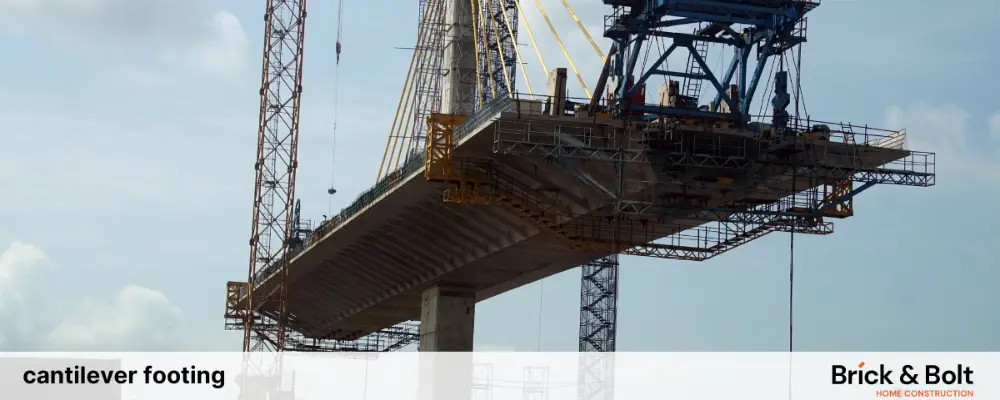Everyone knows the importance of foundation. The foundation must be strong enough to balance the whole building or structure. Otherwise, everything will be collapsed. A strong structure cannot stand without a robust foundation.
Only a strong foundation can support the entire building or structure. To achieve the perfect foundation, cantilever footing is widely used in construction projects. Let us see the types, advantages, and applications of cantilever footings.
What is Cantilever Footing?
A cantilever Footing is a foundation that extends beyond its support base, distributing loads effectively. It is the base for all buildings and structures. It provides durability and strength to the building or the structure.
If there is not enough planning for a strong foundation, you must not expect the desired outcome of the building. Effective planning and designing help to build a solid foundation. It also helps to prevent settling, which means the downward movement of the building due to poor soil.
Why is Footing Important?
Footings provide a strong connection for one or more columns of the building or the structure. It helps to balance the loads of the building by transferring them from the external to the internal side of the building. It can also spread the loads at equal proportions to avoid further damage to the building. The strap beam distributes the loads to the columns and transfers the weight to the soil.
Types of Cantilever Footing
Different types of cantilever footings can be used in the construction industry. Each one had its unique features and advantages. Choosing the right type for your construction project is in your hands. The two types of cantilever footings in the construction industry are as follows:
- Uniform strap cantilever footing
- Non-uniform strap cantilever footing
1. Uniform Strap Cantilever Footing
A uniform-strapped cantilever footing is intended to provide a means of connecting two columns with a strap beam of a rigid nature and one that is equal in proportions. The load is uniformly distributed through the footing into the strap beam and differentially settles to provide structural stability. The footing is useful if, for example, you have two closely positioned columns and, for balance through the structure, the amount of load from both columns connected to the footing needs to be the same.
2. Non-uniform Strap Cantilever Footing
A non-uniform strap cantilever footing is used when variations in load conditions or dimensions warrant using different design properties. For example, a strap may vary in size or thickness along its span to more effectively respond to variable but anticipated loading conditions in comparison to both uniform strap cantilever footings and strap beams. When specific column loads experience different levels of stress, a non-uniform strap bearing the load can improve load transfer between competing footings.
Design Considerations of Cantilever Footing
The ultimate things that can be considered before designing footing include soil investigation, footing dimensions, eccentricity, vertical & horizontal loads, and a minimum depth. It should be 50cm for sloping sites, 60cm for rocky soil, and 90cm for below-ground surface. This special type of footing connects one or more beams by a strap. Some points are as follows:
- The cantilever footing is purely flexural, which can easily bend or fold.
- It is lightweight and doesn’t remain in contact with the ground or soil.
- It distributes the heavy loads from external to internal parts of the supporting beams.
- This strap beam is subjected to bending moment and shear force.
- The beam which is located at the boundary of the plot has eccentric load footings.
- It is mainly used to balance the asymmetrical loads of the structure.
Advantages of Cantilever Footing
The major advantages of cantilever footing are as follows:
- It needs only a limited space to provide a better foundational structure.
- Mostly suited for the urban development process
- Secures the safety of the long-built walls.
- It helps to build strong buildings even in poor soil conditions.
- Widely spaced columns with supported beams distribute the loads evenly at every corner.
- It prevents the structure or building from settling.
Disadvantages of Cantilever Footings
The major disadvantages of cantilever footings are as follows:
- The design of the cantilever footings is more complex.
- It is more difficult to construct than the traditional footing method
- It requires more attention and detailed engineered knowledge to prevent failure.
- It also acquires high costs for the construction process
- The cantilever structures are always concerned about the safety of the workers.
What Conditions Might Call for Cantilever Footings?
Cantilever footings are used when you don’t have a sufficient area to move the foundation to the underground terrain. It can also be used when the soil cannot bear the loads from the structures and transfer them to the ground. In this case, the size of the footings can be increased out of the range.
If a column is constructed near the boundary of the plot and cannot be extended further, cantilever footings are used. If the distance between the two consecutive columns is large, cantilever footings are used to interconnect them and transfer the load evenly. If combined footings fail, strap footings help to increase the soil’s load-bearing capacity.
Overall, strap footings play a crucial role in providing strength to the structure. When the columns are built far apart, strap footings are used to combine one or more footings with a beam. They evenly distribute the loads from the structure to the beams. Without them, the building cannot withstand the test of time.
FAQ’s About Cantilever Footing
The ultimate purpose of the cantilever footing is to support the foundation of the structure or the building and prevent settling.
Another name for cantilever footing is strap footing.

